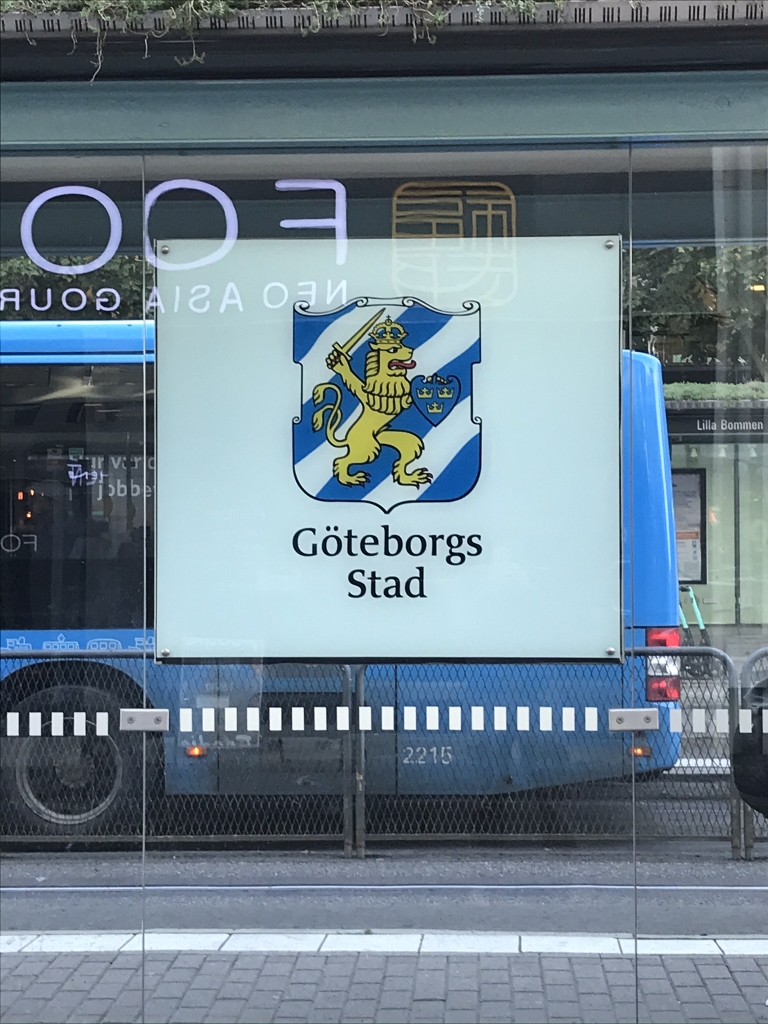Copenhagen was an exciting city but it was now time to move on. Next I would be going to the northernmost point on this trip: Gothenburg, Sweden. This would also have the distinction of being my first time ever visiting Sweden.
Thursday, September 24, 2020
Thursday morning I had to be on a train leaving for Gothenburg at 10:01. However that train was leaving from Malmö, on the other side of the Oresund, and I was still in Copenhagen. But there's trains regularly crossing the Orebro--the bridge over the sound--so getting there should be no trouble, right?
So I had my last breakfast at Urban Camper, another simple but delicious sandwich and a couple buttered rolls, packed up, checked out, and easily made it back to the central station via S-tog. Of course, first thing I did, after getting coffee, was get a train ticket to Malmö.
The way tickets worked for this particular train service was a little confusing. I bought the ticket from one of the machines, and that was simple enough. But this ticket didn't specify any departure time or track number at all. So I had a ticket for a train, but where was I supposed to find this train, and when would I have to board it? I had to ask someone at the DSB office and apparently it was valid for any train going over the bridge. There was one leaving in about twenty minutes; nowhere on the screen was the word "Malmö" but simply that its final destination was (I think) Helsingborg, and that it was stopping at Copenhagen airport.
So, I made one last stop at Espresso House to spend the last of my Danish Kroner and get a bag of coffee beans to take home, and then found my train. Trains that traverse the Orebro are branded "Oresundståg" which means "Oresund's train" in Swedish. I don't remember how long this trip was, but it wasn't very long. It made a stop by the airport, then went over the bridge where I got a good view of the wide strait--the Oresund--that separates Copenhagen and Malmö. At some point a conductor came by checking tickets, and accepted the one I had, so it looks like I did this right.
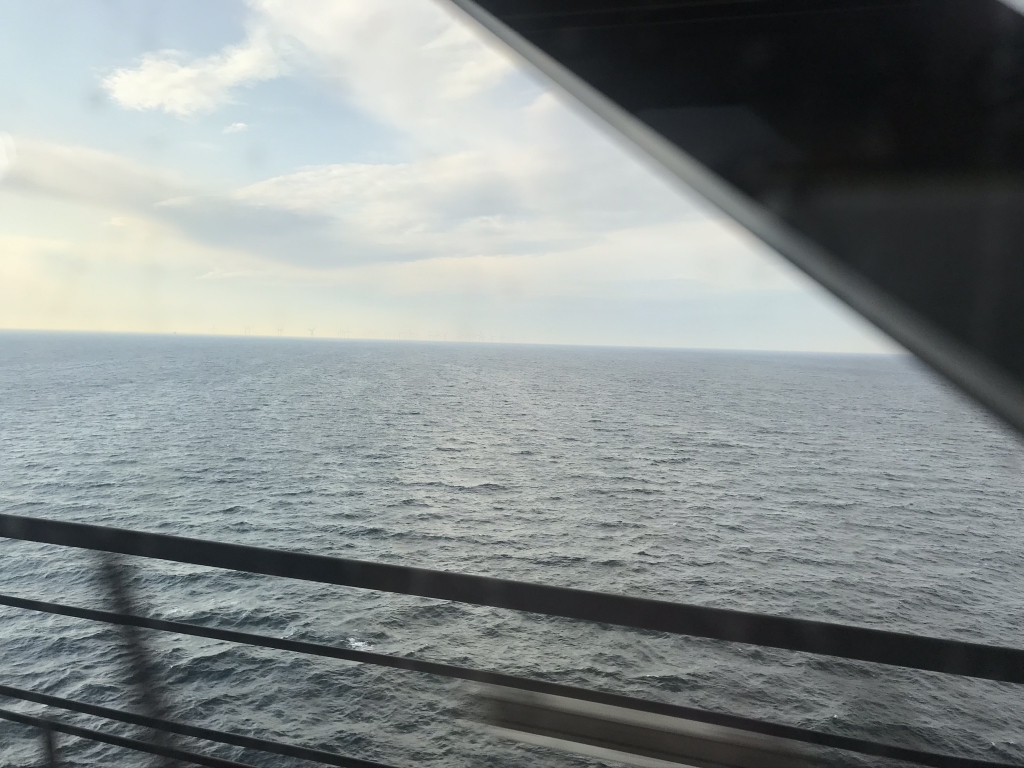
The Oresund, seen from an Oresundståg crossing the Orebro. Hard to get a good pic with all the pillars and trusses flying by. You can just barely see a bunch of wind turbines off in the distance. Offshore wind farms generate a lot of electric power here.
I only had an hour to kill in Malmö. Not enough time to do anything except walk around outside, so that's what I did. I really wanted to see something of this city for a reason. Way back in 2008 when I lived and worked in Bellevue, Nebraska, a suburb of Omaha, I occasionally made day trips in my car out to small towns that were named after European cities. Back then a European vacation wasn't anything I could afford, and this way I could visit all these places and then tell all my friends on MySpace "hey, I just went to [name of famous city] today!" Back then I went to Prague, Geneva, Genoa, and Cairo, all in Nebraska, as well as Hamburg, Iowa and Bern, Kansas, but the first one I ever went to was Malmo, Nebraska. I've been taking every chance to visit the cities all those towns were named after; In the past decade I've been to the original Prague, Hamburg, and Geneva, so there was no way I was going to pass up Malmö on this trip.
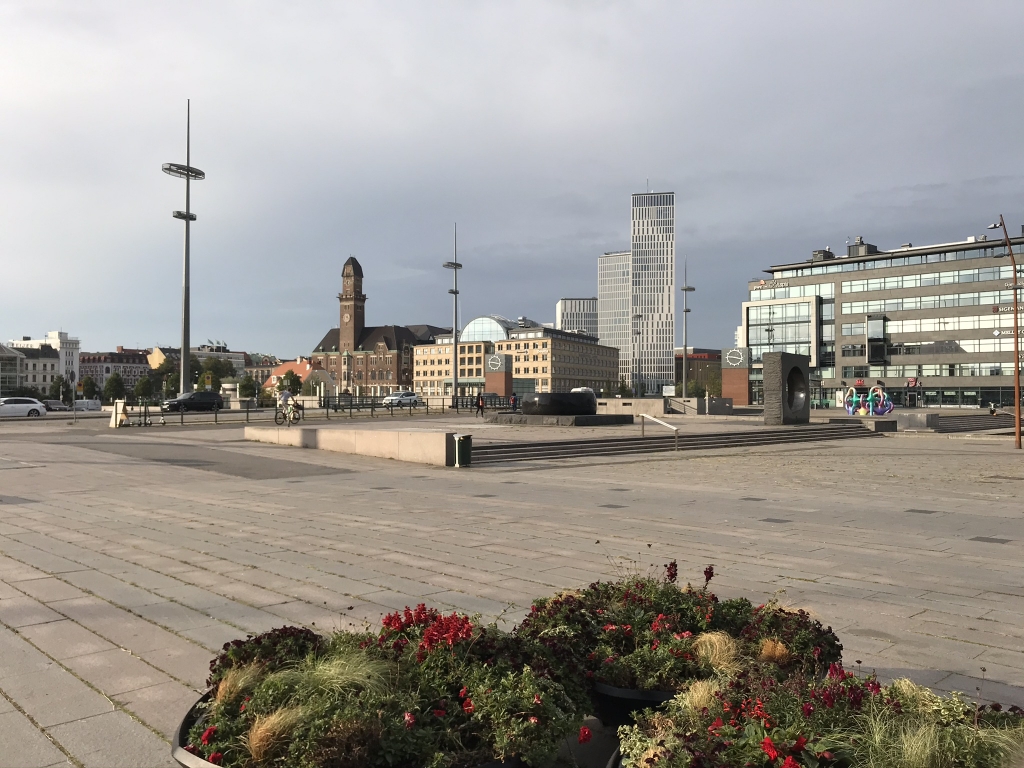
I never saw anything like this in Malmo, Nebraska.
So after strolling around downtown Malmö for awhile I headed back to the station to board my next train. This one was a "Snabbtåg," which is apparently Swedish for "fast train." So, does that mean it's "snappy"? It took about two and a half hours for this Snabbtåg to travel from Malmö to Gothenburg. There were no displays anywhere telling me how fast the train was going, so I don't know how this stacks up against ICE in that regard. One thing I do remember about this trip is the free coffee and water. I actually had a first-class seat reservation; I don't remember why I bought it, maybe it was just relatively cheap, but in that first-class car there was a coffee pot that passengers could fill a cup from at any time. Nice.
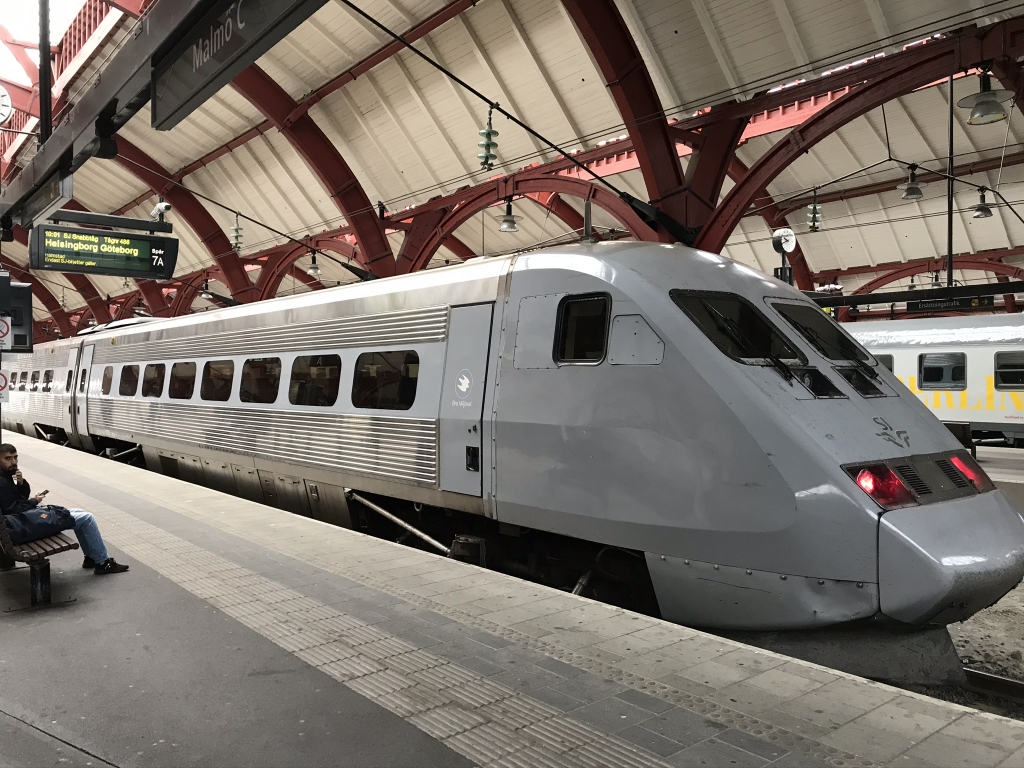
A Swedish high-speed train waiting to take off from Malmö to Gothenburg with me on it.
Finally the train reached its, and my, final destination, Gothenburg. Or as it is called in its native Swedish, Göteborg. As I learned from the announcer, Göteborg is pronounced something like "yewtebory." The first thing I had to do at the train station was get lunch, and what I ate for lunch was the last thing I expected to find there: a poké bowl. And after that, I had to figure out how to use yet another public transit system.
Gothenburg's transit system consists of tram and bus lines. It's not a huge metropolis like Copenhagen or the Ruhr area so there is no subway or commuter rail. There were no machines dispensing transit tickets so I had to actually buy one from a person behind a counter. The ticket wasn't the usual paper ticket but a smart card you activate by tapping a scanner with it on the tram or bus. I bought an all-route pass that was good for the next 24 hours, which was as long as I'd be in the city. It cost me 33 Swedish Kronor, which is about $3.63.
Speaking of money, while I was in that train station I also got some cash from an ATM. That turned out to be a mistake because most businesses in Sweden weren't accepting cash due to the pandemic. Still, though, I still got to handle yet another kind of currency...
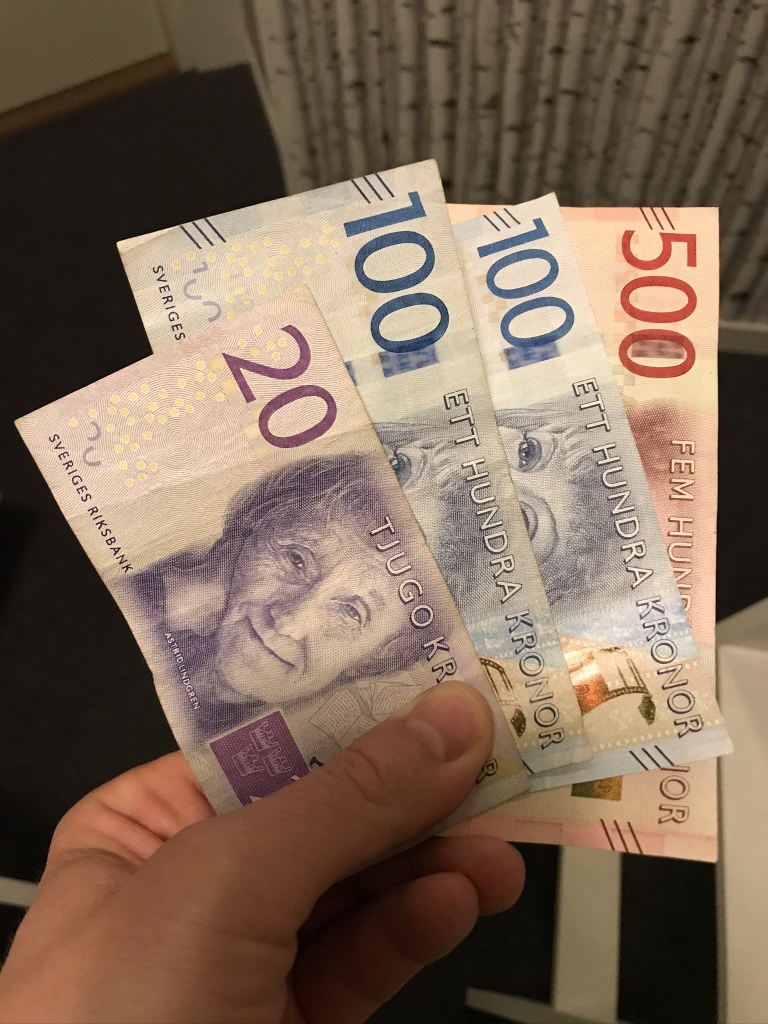
The exchange rate naturally fluctuates, but 10 of these are worth about $1.10. That means they're worth less than their Danish counterparts which hover around 10 for $1.60.
Next I had to get to my hostel. This wasn't that hard; I had to spend some time riding a tram to the Olivedalsgatan stop, and then hike up a steep hill on the street that stop is named for, until reaching another street called Vegagatan where the hostel was. Here I checked in and left my bags in the room I had reserved.
The room where I stayed that night wasn't the best. It was small and somewhat cramped, with no windows, and the four beds folded out of the walls. It made me feel like I had booked a berth in a cargo ship. But on the other hand, I was the only one staying in that room that night, for which I was a little grateful. I wouldn't say I'm over hostels yet, but at this point in the trip I had had enough of sleeping a few feet away from someone else in the same room.
I did a lot of walking around that afternoon. Instead of getting back on the tram, I walked down a long, narrow street called Haga which was lined with shops, restaurants, bars, and cafés. All I needed at this point in the early afternoon was some coffee, which I got from one of the cafés. I didn't stop at any bars, though, because after the previous night's beery adventures I was refraining from any alcohol this whole day.
After getting to the other end of Haga I walked along the pier a bit, and from there into downtown.
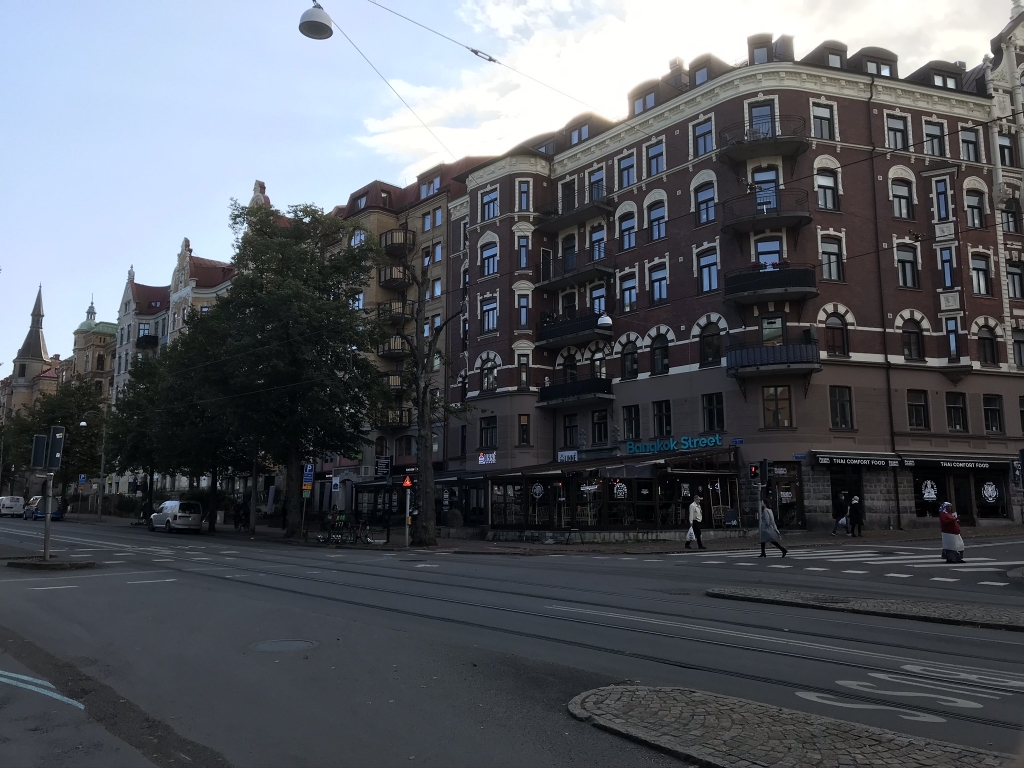
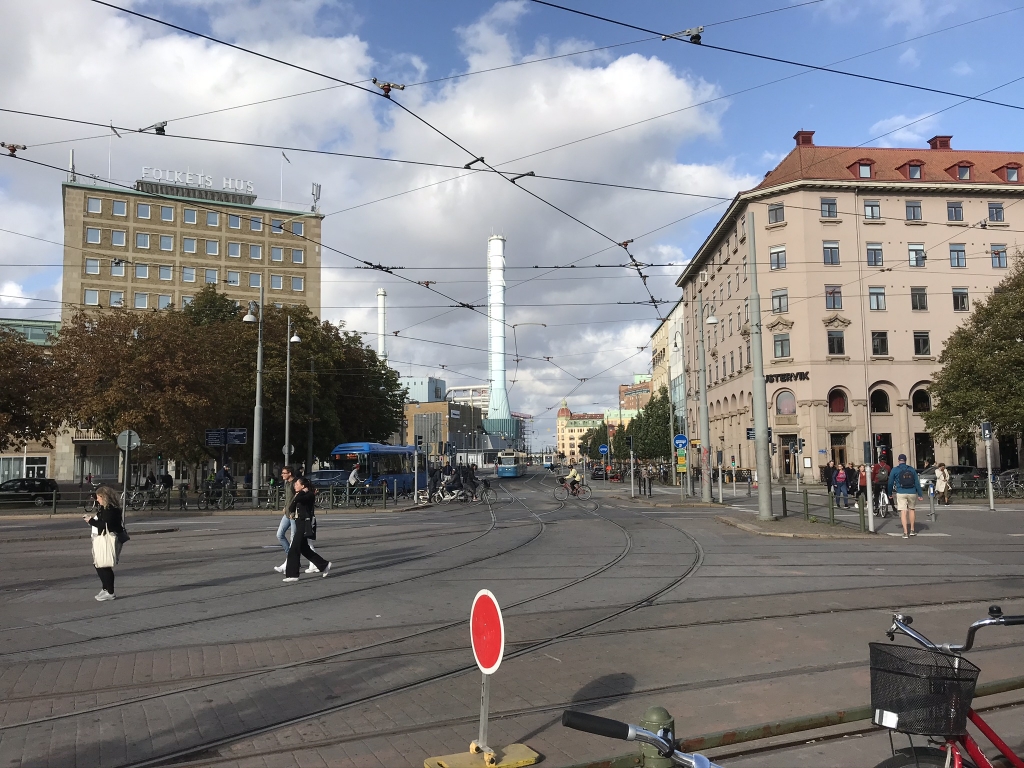
Eventually I found my way to the pier.
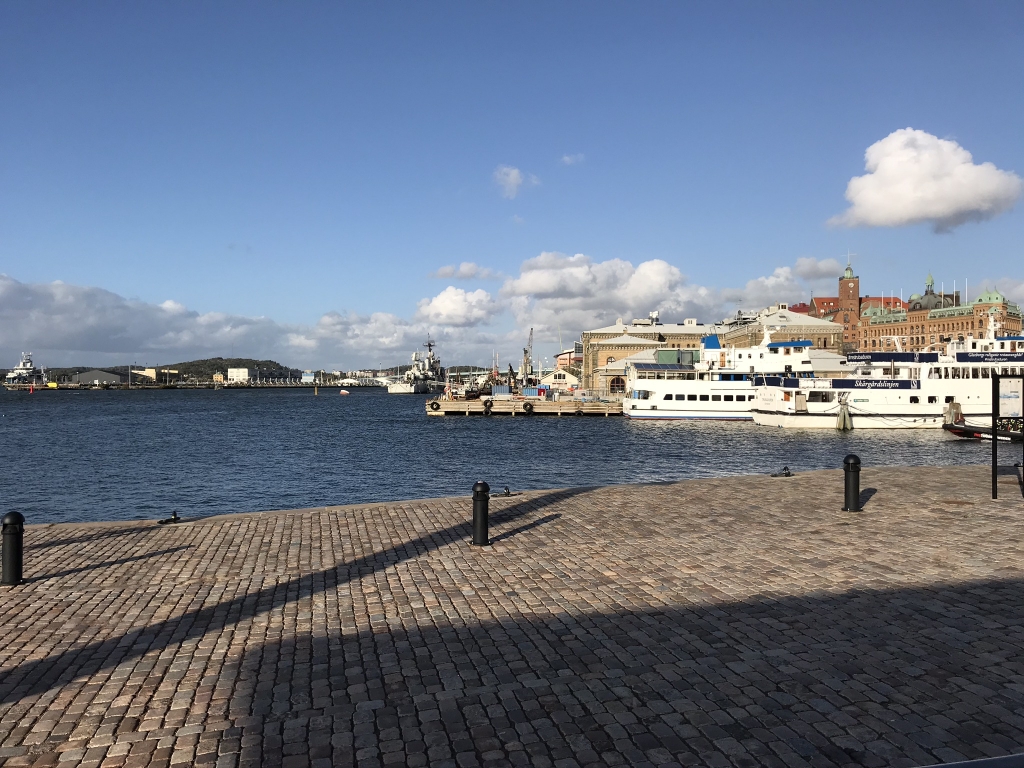
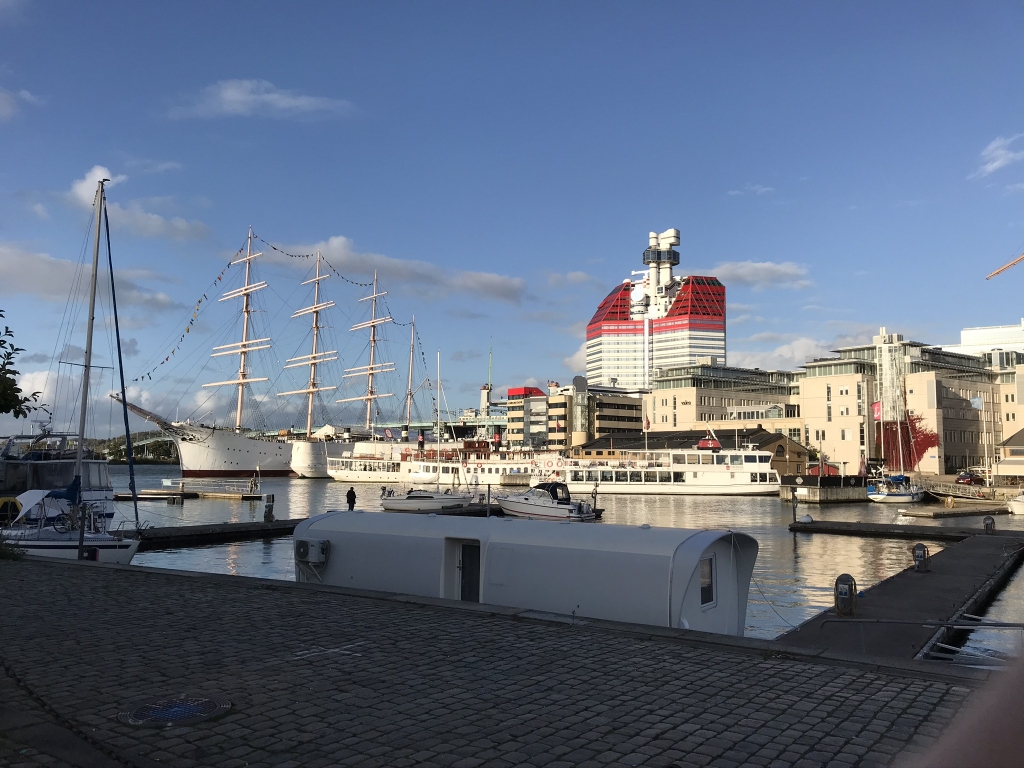
In a less-plague-ridden era I'd be taking a harbor cruise on one of those ships.
Eventually I found myself at a downtown shopping mall, Nordstan. Here I started to notice how Sweden's response to the Coronavirus pandemic was different from other countries'. Most obviously, absolutely no one anywhere was wearing a face mask. Chances are you've probably already heard that about Sweden by now. But they clamped down in other ways that other countries did not. For one thing, there was Plexiglas everywhere. Sure, other countries also have Plexiglas panes separating clerks from customers, but not nearly to this degree. And more noticeably, a good deal of businesses were not accepting cash. I got a cup of coffee at a café in the mall and tried to pay for it with cash, only to be told only a credit or debit card would be accepted. Most other establishments I visited on this trip were the same way.
I also first noticed a couple of Swedish national quirks in this mall. The first concerns public restrooms. This is the only country I'm aware of in which there are no separate "men's" and "women's" restrooms, just one big room with a bunch of individual toilet stalls. Actually I don't think I consciously noticed it in the mall, but at a restaurant later. Needless to say, there are no urinals anywhere at all.
As with any other city I visit, I had to get a few consumable souvenirs at a local store, and there happened to be a Lidl in this mall. I got my usual brick of ground coffee, a bag of müsli, and some fresh fruits along with another addition to my collection of reusable grocery bags. I also wanted to get some beer to take home, and this is where I ran into Swedish quirk #2. There was a typical variety of beer for sale, but every single one was 3.5% ABV. The first one I looked at, I just thought that particular brand was weak, but I looked at everything on the aisle and saw nothing but 3.5, 3.5, 3.5... Is this seriously all they drink here? I thought. I didn't buy any (though looking back maybe I should have just for the novelty of it), but mentioned it on Facebook where someone commented "That's Utah level beer!"
When I stopped back at the hostel to drop off my groceries, I asked the receptionist what the deal was with the weak beer. So restaurants and bars can, of course, serve full-strength beer, wine, and liquor, but grocery stores can't. If you want to buy the real thing to take home, you must go to a special government-owned store called Systembolaget. I planned to go to one of these later, but every time I went to one the next day the lines were prohibitively long.
It's not just alcohol they have this attitude toward. I don't remember where I read this, so don't quote me unless you can track down the source, but I know I read somewhere that unlike most other western Europeans, most Swedes are dead set against the idea of legalizing cannabis. For a people who are so synonymous with progressive values (see quirk #1), they sure are prudish in other ways.
Then it was back to Haga where I was looking for somewhere to eat dinner. The place I decided on was called Sjöbaret. Here I had a delicious, creamy seafood soup and garlic bread. What seafood was in this soup? There must have been at least four kinds of fish in there. If you're looking for a great meal on Haga, I'll certainly recommend Sjöbaret.
About now as I was walking back to the hostel, I have to mention Swedish quirk #3: They’re a bit more relaxed about obeying walk/don’t walk lights than, say, Germans. In fact some intersections don’t have lights or even crosswalk markings; people just look both ways and go for it. It took a little getting used to after living in Germany where everyone is a stickler for obeying the signs.
Friday, September 25, 2020
Slottskogen Hostel served a breakfast that included müsli, so they get a thumbs up from me just for that! Also, since I had to check out at that moment but wouldn't be leaving the city for several more hours, they let me store my stuff in a locked room while I spent the day out in the city looking for things to do.
Walking around Gothenburg on that morning I steadily noticed Swedish quirk #4: they really love their national colors. Everywhere I looked, I kept seeing ordinary things lit up, decked out, or painted blue and yellow...
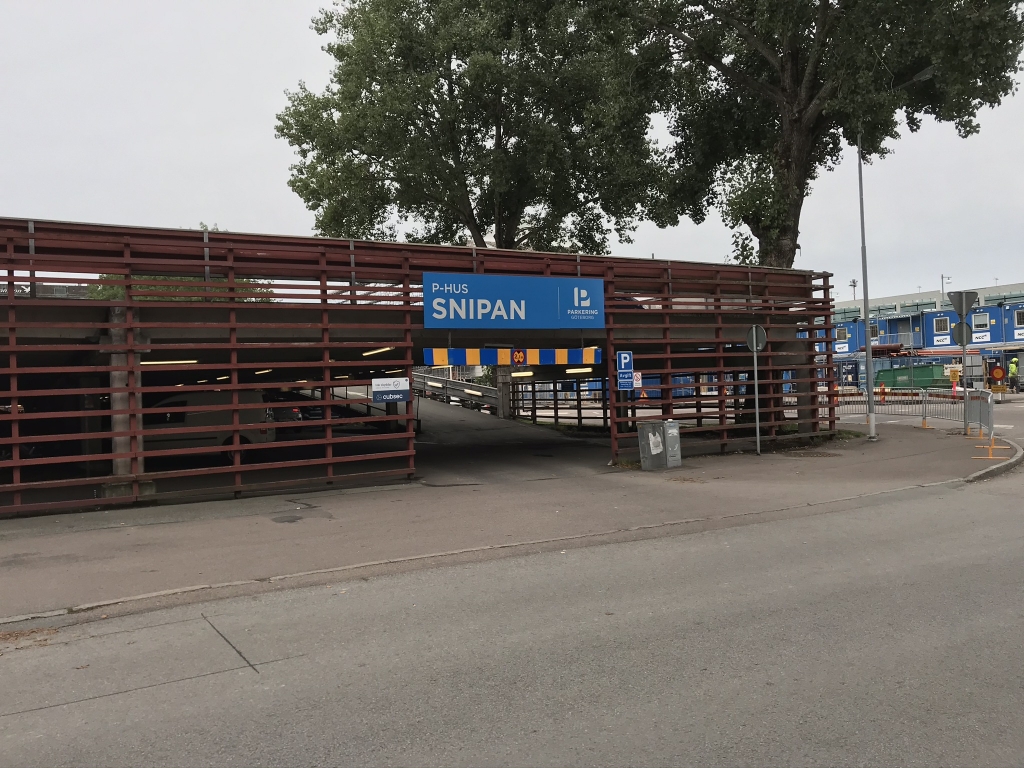
Like this. Anywhere else in the world, those stripes would be red and white.
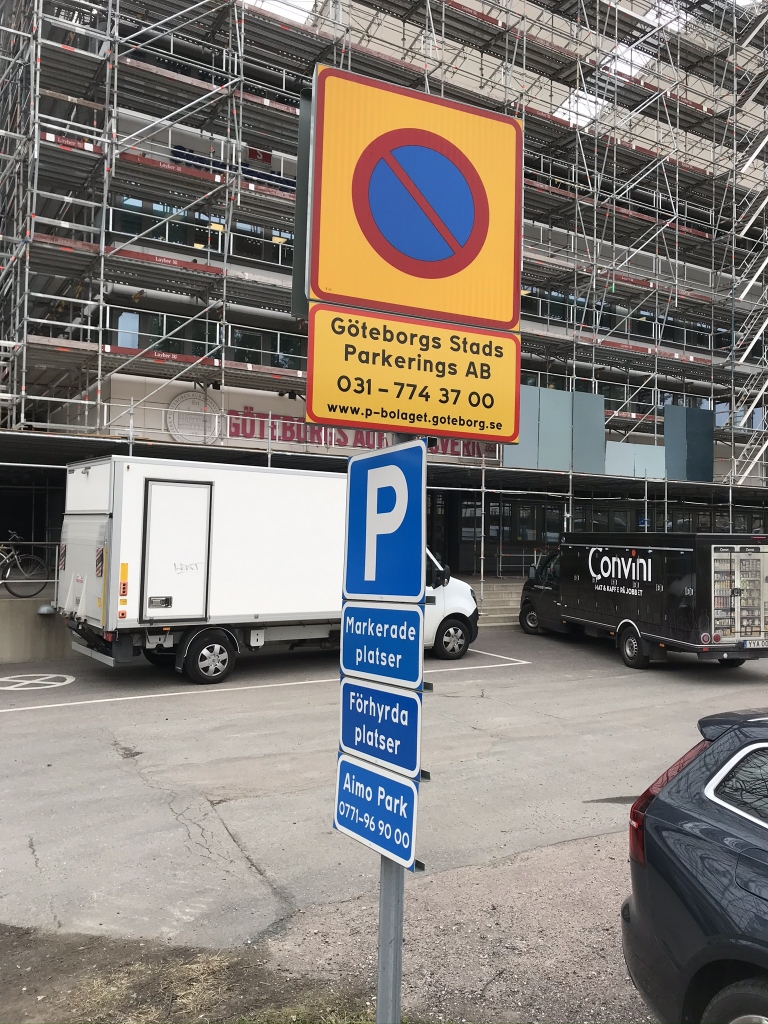
Even signs that would be painted white in other countries are yellow here to complement any blue sign they happen to be placed next to.
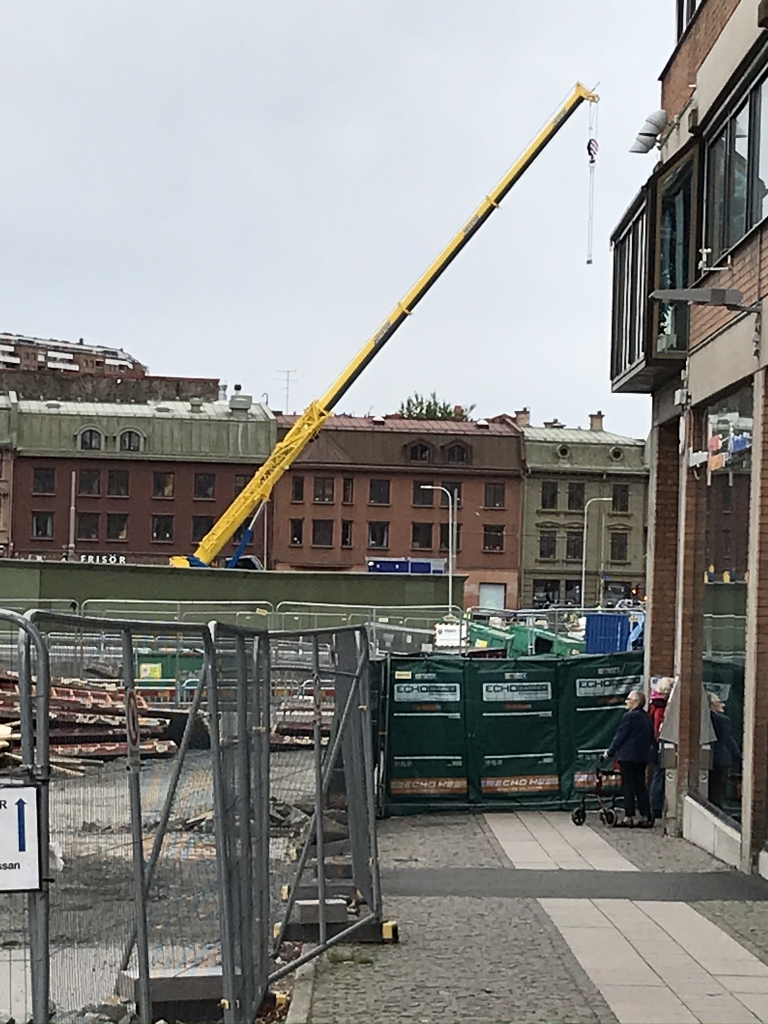
Blue and yellow is everywhere.
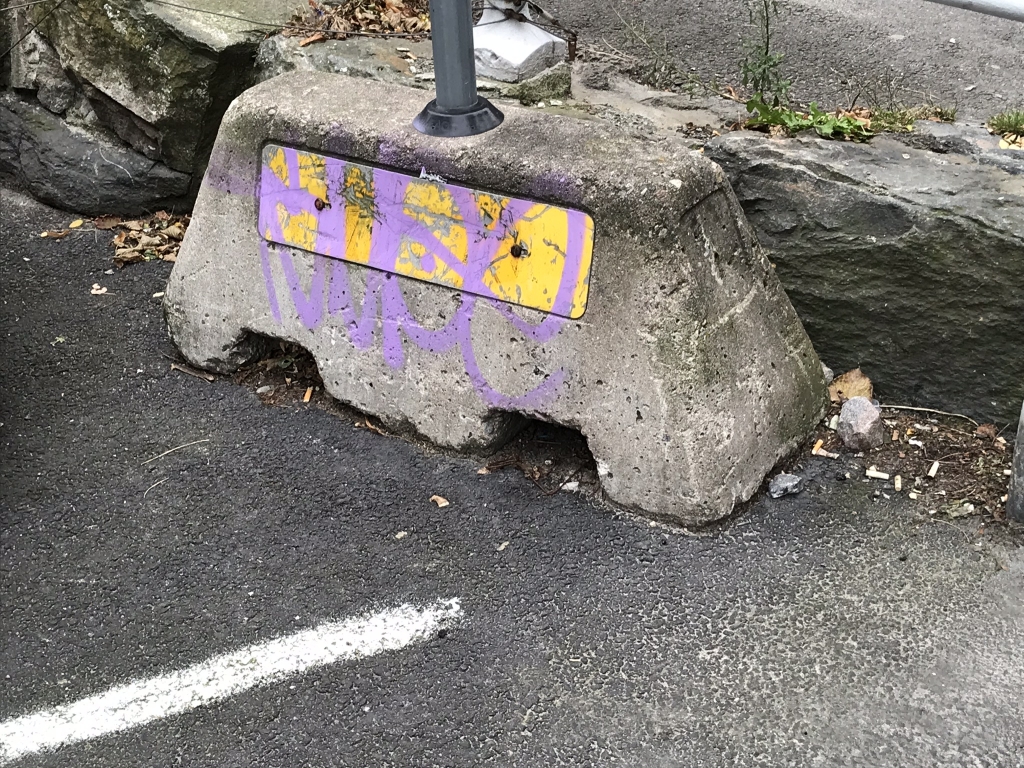
It's everywhere...
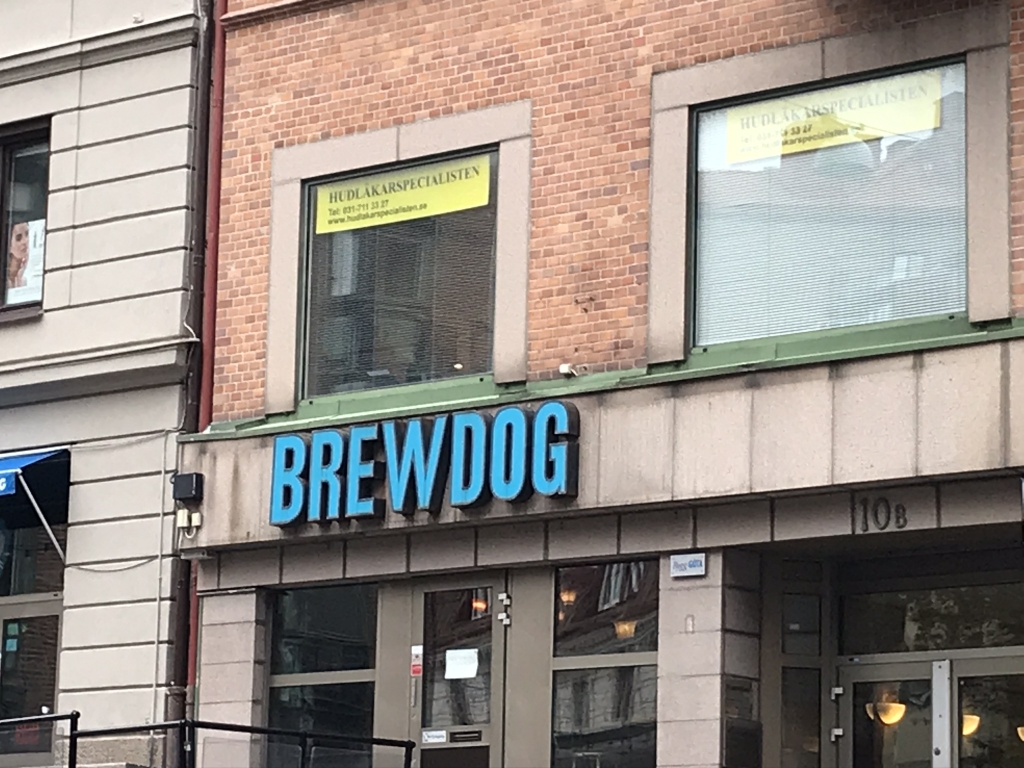
Everywhere...
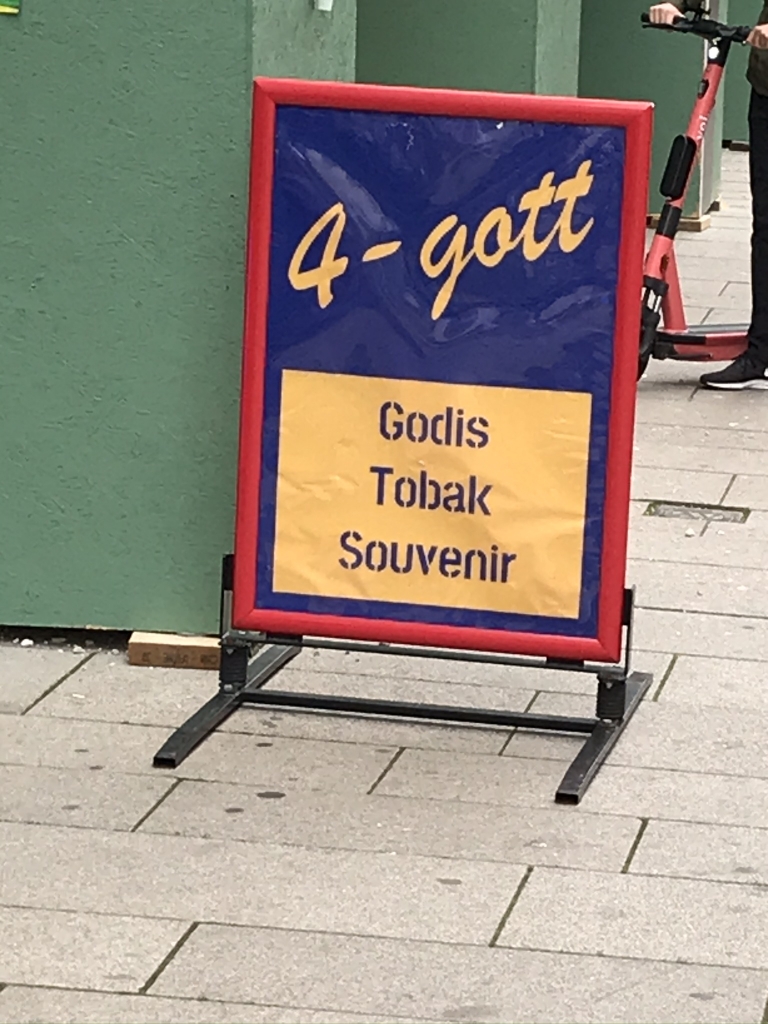
Everywhere!
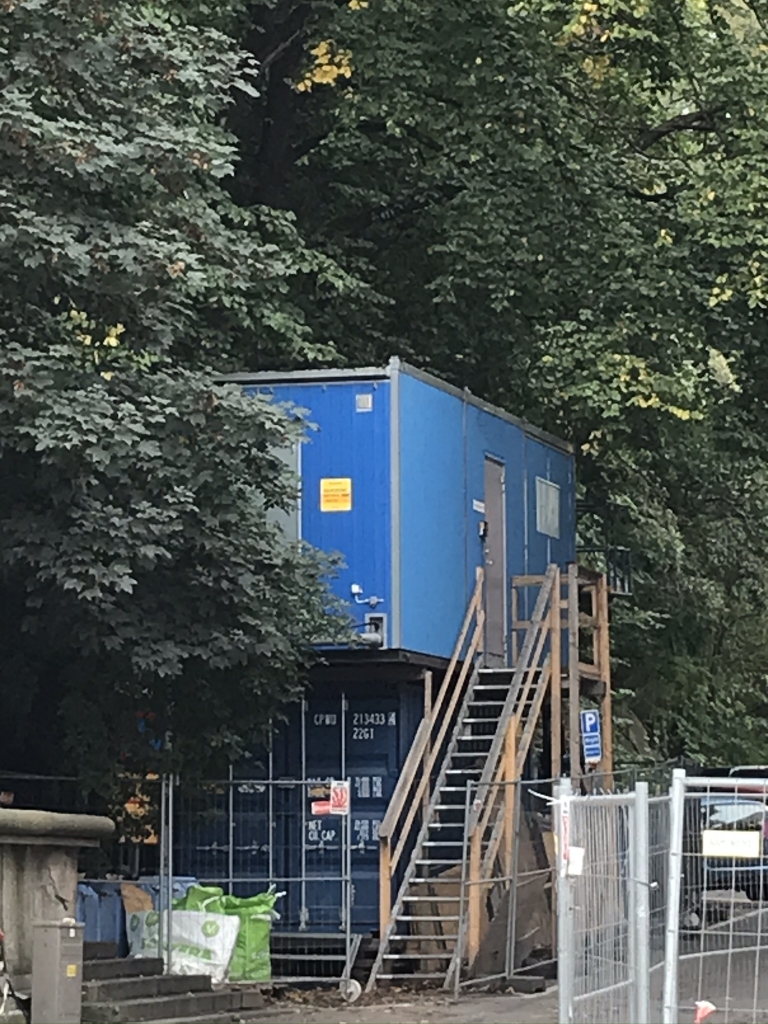
Even in the States you don't see red, white, and blue as often like this.
Unfortunately there wasn't a whole lot to do out in the city. Apparently this was another way Sweden was making up for the lack of masks to combat the pandemic, keeping more places shut down than other countries were. Two days earlier I'd ridden a Hop On Hop Off bus in Copenhagen, and earlier in the summer I'd seen those buses operating in other cities like Hamburg and Salzburg. But in Gothenburg I only saw signs at their stops saying they'd be back in 2021. OK, what about boat tours? Most of them were cancelled, too. The only boat tours still operating were evening dinner cruises that didn't start until after my ferry out of the city was leaving. I stopped by a tourist office downtown where someone gave me a map on which she marked certain places to go, mostly parks and the art museum.
With little else to see that day, I headed to the art museum, Göteborgs Konstmuseum. I don't usually go to art museums, in fact I was trying to avoid museums on this trip, but there wasn't much else to do with everything being shut down, so I thought I may as well check it out. Admission was 60 Kronor, or about $6.66.
If you like art museums you should probably stop by this place. I don't know much about this world, though, so I couldn't do much but look at all the paintings and such and think "well, that's interesting." It was mostly paintings, dating from several different centuries, along with one big photography exhibit, and some sculptures. I did have to stop and take pictures of two things.
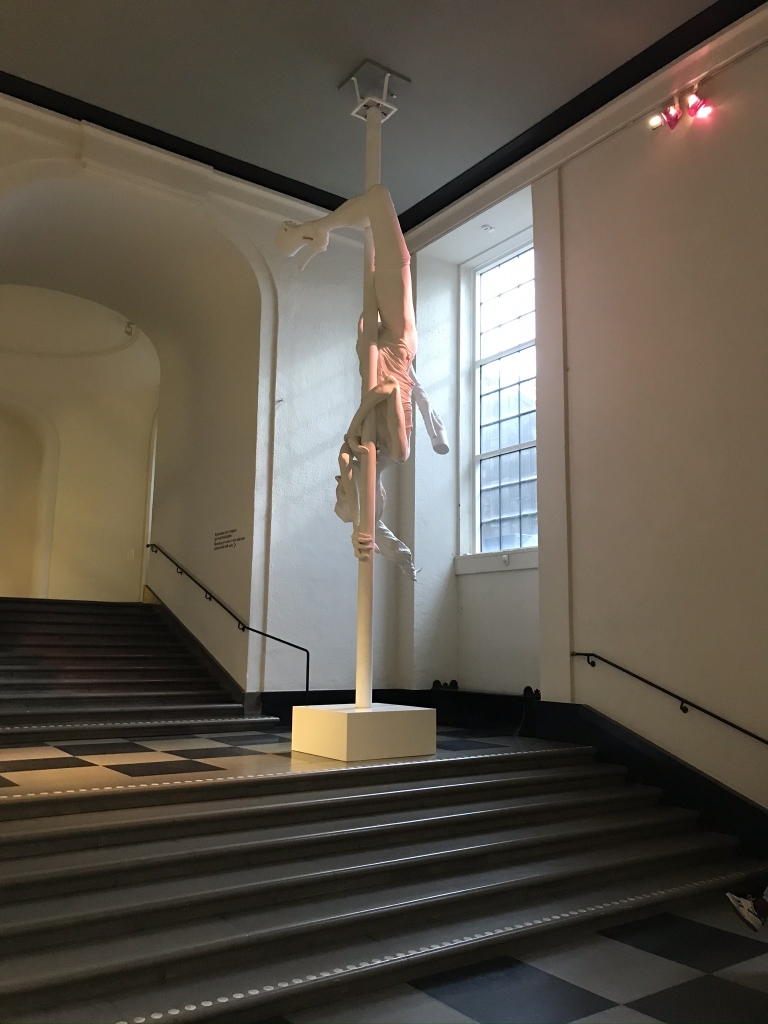
This was certainly eye-catching. It's called "Six Seconds of Ecstasy." You can't tell from the photo but it's at least twice as tall as I am, and it slowly rotates. I'm not sure what the artist was trying to say here.
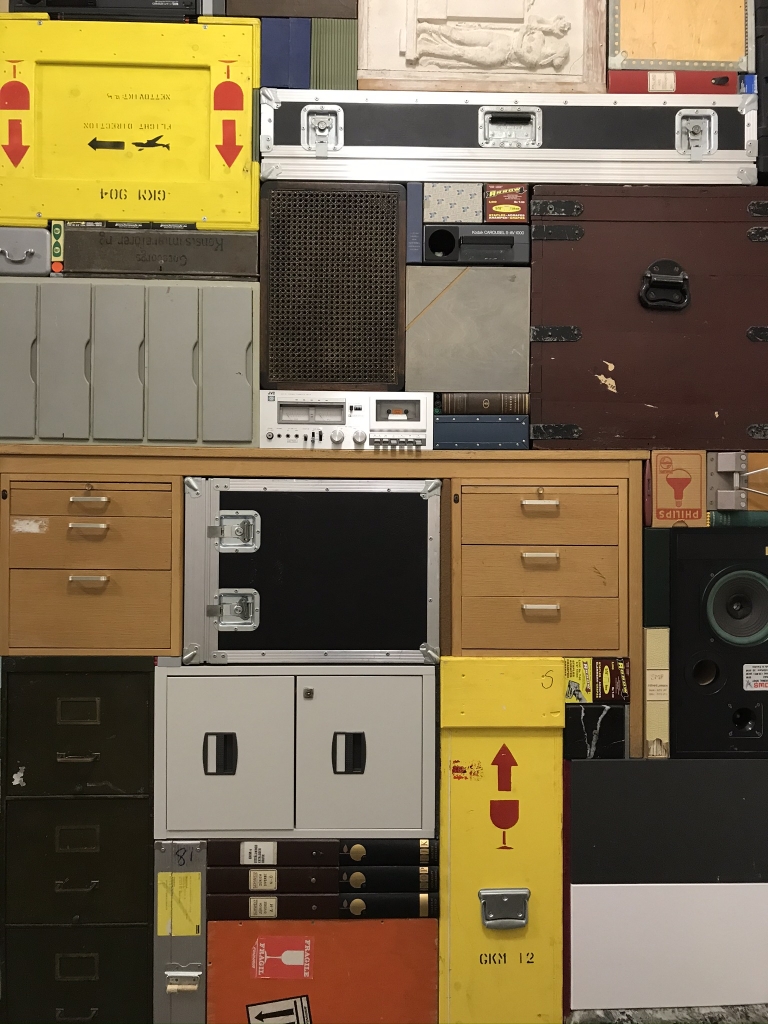
This, I just kind of liked how it looked. An artist stuffed all these ordinary blocky objects, including a desk and varying kinds of boxes, together in one space and fit them perfectly together without any empty space between them, or uneven edges.
I took my time to go through every floor of the museum and gaze at all of the artwork. By the end I was pretty hungry. Along one of the main streets, Vasagatan, are a number of restaurants and bars, and after spending way too much time looking walking up and down the street peering at posted menus, I finally settled on a restaurant called Lilla London. There I had a fish soup for lunch. It looked, smelled, and tasted the same as the one I had the night before at Sjöbaret, and that's a good thing because that means both soups were equally tasty! Also, since a day and a half of alcohol abstinence was long enough, I had my first Swedish beer here: 40cl of Pripps, a pretty standard lager. It wasn't bad, but not particularly memorable either.
At another stop on Haga, Gotlands Bryggeri, I had 40cl of Melleruds Pilsner. That was a good one, but not as good as the 40cl of Eriksberg I had at one more bar called Marinade. I tried to spend the Kronor I had in my wallet at these places, but thanks to the pandemic, no one was accepting cash anymore, only credit cards. Looks like I'd have to stop by a currency exchange office the next day.
I still had some time left before my ferry took off, so before picking up my stuff from the Slottskogen hostel, I took a stroll around Slottskogen, the park for which the hostel is named.
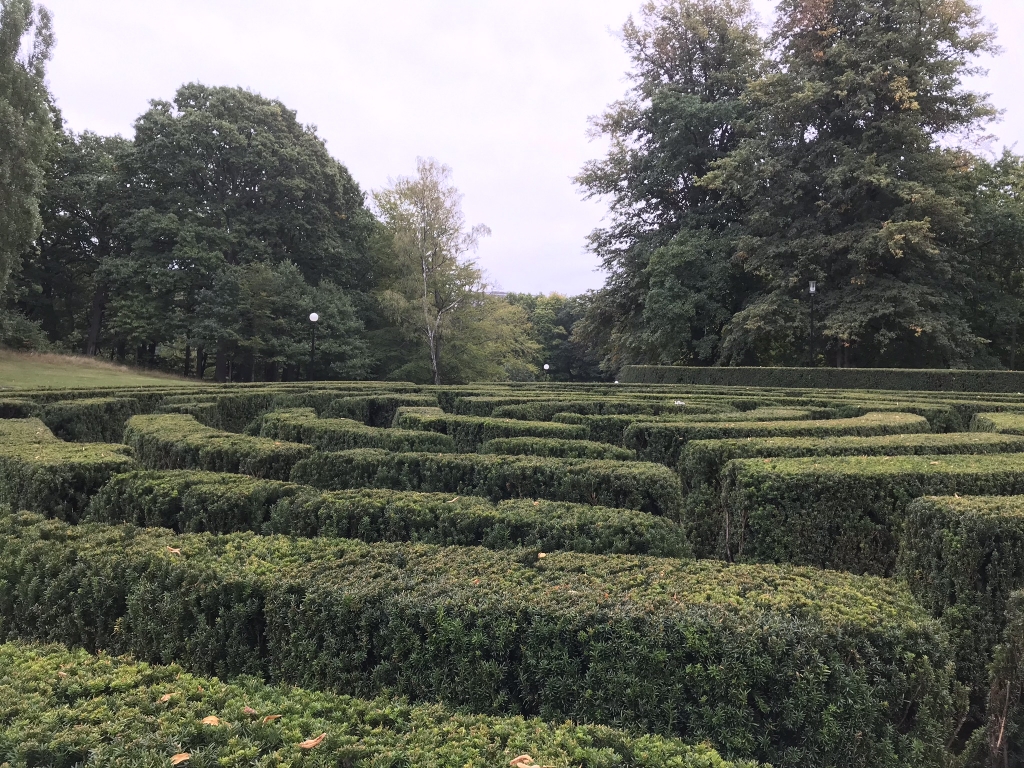
Cool, how often do you ever see a hedge maze?
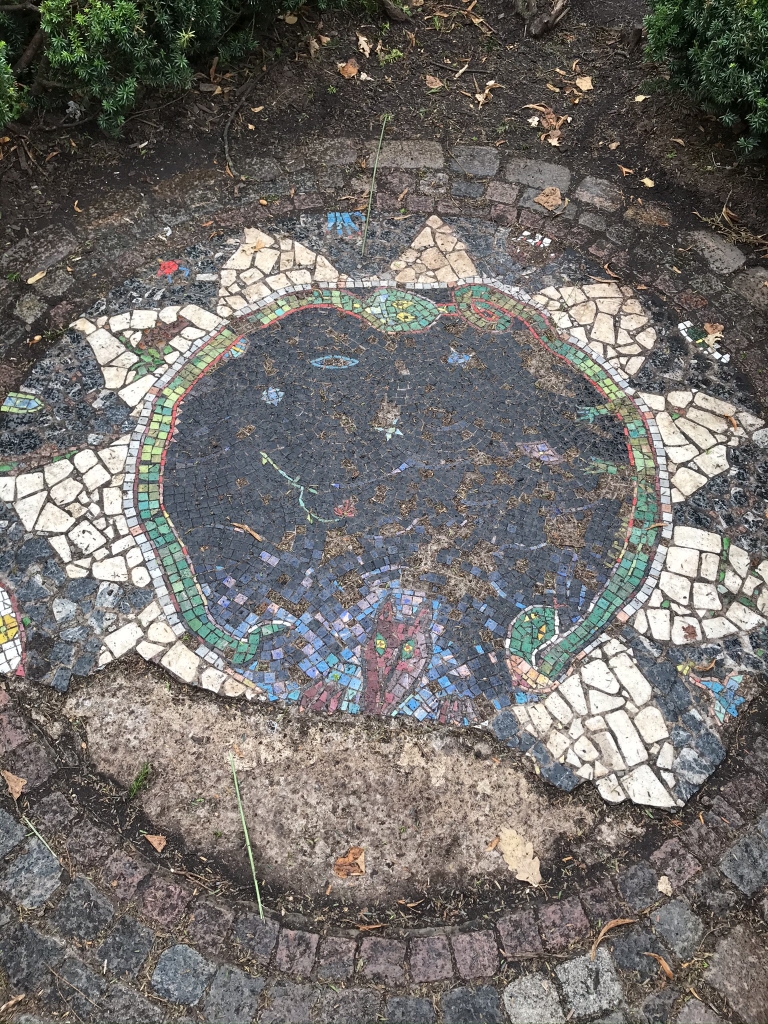
This was in the center of the hedge maze.
There was also a natural history museum nearby. I don't know if it was open or not, but there wasn't enough time to check it out if it was. So, back to the hostel to reclaim my heavy backpack and two bags of groceries.
While I was collecting my things inside, the weather had only gotten worse. It was dark and cloudy when I went into the hostel, but when I stepped outside, the rain was falling. On my way to the Olivedalsgatan tram stop, I walked by a Systembolaget, since this was my last chance to buy some beer, but there were so many people waiting in a socially-distanced line stretching endlessly outside the door, I decided it wasn't worth the wait and took the next tram out.
I had to take two trams to the ferry terminal, and they were worryingly packed. The first one, from Olivedalsgatan to Jarntorget, was the worst, with so many people packed in there and not a single one wearing a mask, I thought to myself, if I test positive for Covid next week, I'll have caught it right here. The second tram, from Jarntorget to my final destination Jaegerdorffsplatsen, was better; it was somewhat crowded when I stepped on, but it gradually emptied at every stop so by the time I stepped off it was thankfully spacious.
Jaegerdorffsplatsen is where you must go if you're catching a Stena ferry out of Gothenburg. It was a short walk from the tram stop to the terminal entrance, and it was only raining harder than earlier, but it didn't take long to get inside.
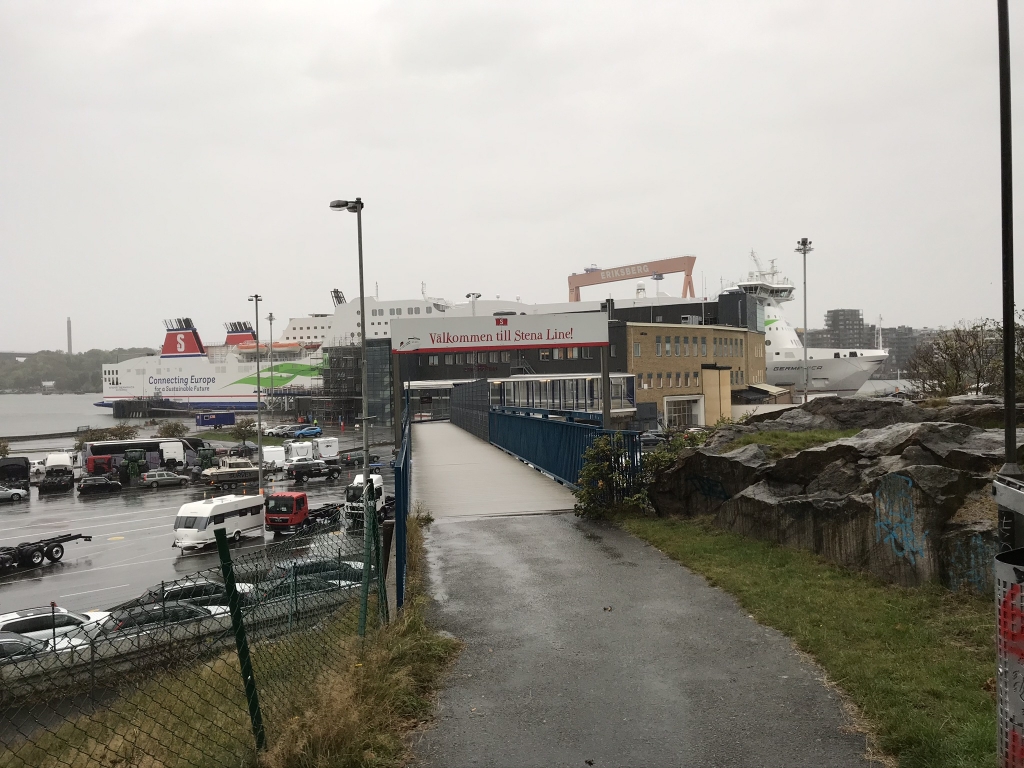
Inside the terminal it didn't take long to get checked in. I had to show my passport, though I think that was just being used as a form of ID, since Sweden is a Schengen country and they didn't stamp it. They issued me a paper card that would be used as a keycard to my stateroom, and then I just walked right on board.
The Stena Germanica was like a cruise ship, though much smaller. It reminded me of the Carnival cruise ships I'd been on, though much leaner with a lot less of the amenities. If an ocean-going cruise ship is like a floating all-inclusive resort, this was a floating two-star hotel. Like any good hotel, it had a bar and a restaurant.
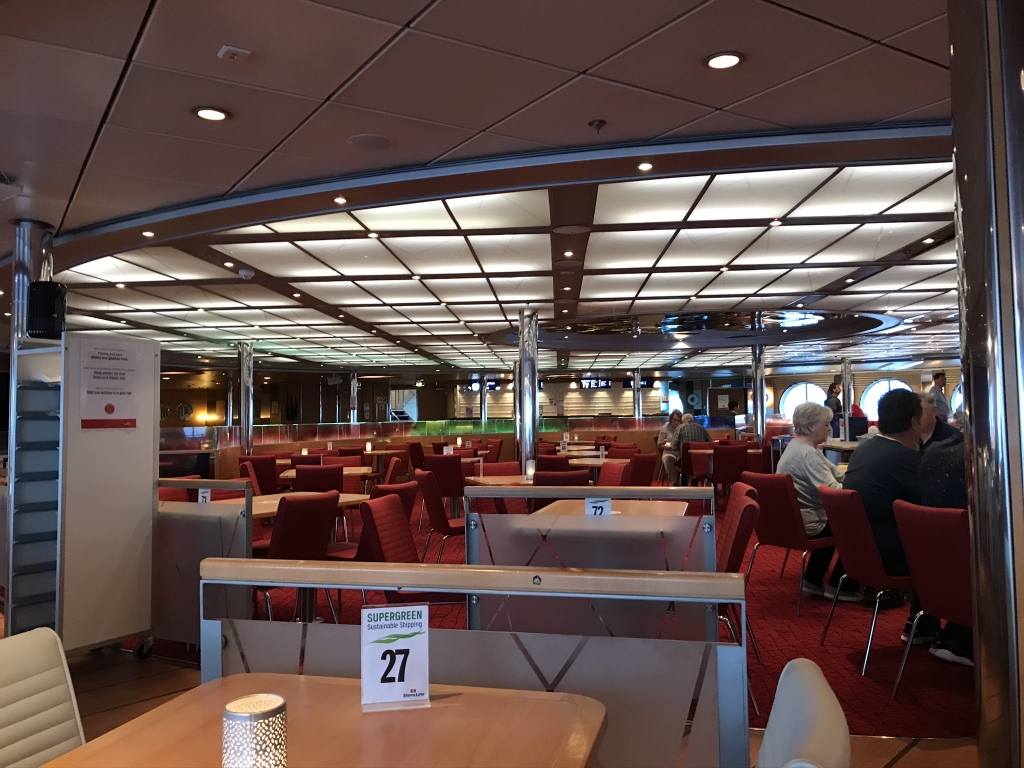
At the bar I found I could order an Irish coffee. They weren't mixing them up behind the bar, though. Instead, they had a big self-serve coffee pot on the bar, next to a whipped cream dispenser, and after paying for the drink they handed me a cup to pour the coffee in along with one of those little bottles with only a shot's worth of whiskey in it. The end product was OK, but not quite as good as one made by a pro.
Dinner on the ship was in a cafeteria-style restaurant where you pick up a tray and go through a line and ask for various items from the cooks behind the counters. I had a salmon sandwich because I wasn't tired of seafood yet, along with my last pear that I had bought from Lidl the day before.
While waiting in the dinner line I noticed that many of the other passengers on the Germanica were truckers hailing from all over Europe. The man in front of me was a trucker from Turkey and struggled to ask for what he wanted for dinner, since he didn't seem to speak many words of any language that wasn't Turkish. In the restaurant there was a whole seating area exclusively reserved for truck drivers. I didn't expect this when boarding this ship, but it seemed to make sense, considering how the North and Baltic Seas cut off most of Scandinavia is from the rest of the continent.
I had a couple 33cl beers in the bar before turning in for the night. Eriksberg Karaktär, since I'd had another Eriksberg a few hours earlier and really liked it, and Carlsberg Hof. They also had plenty of boxes of full-strength beer for sale in a duty-free shop, but I decided not to buy any because with everything I was carrying already, I was loaded down enough. The Tuborg I bought in Copenhagen would be my only alcoholic souvenirs from this trip.
So out of those two Nordic countries, which did I like better? It's hard to say...Copenhagen was definitely my favorite city to visit on this tour, but there was else something about Gothenburg that made me think, this place really feels like home. I'm not sure why, especially with the restrictive alcohol laws. It's not often I get that feeling from a city I visit. The only other cities I've recently been through that gave me that feeling were Montréal and Toronto.
With that, this Scandinavian journey was over. The next morning, I would wake up in Germany's territorial waters as Stena Germanica approached the port of Kiel.
Other articles in this series:
- A Weekend in the Ruhr
- A Night in Odense and a Railway Museum
- Two Days in Copenhagen
- Passing through Gothenburg
- Ending the Trip in Kiel and Hamburg
